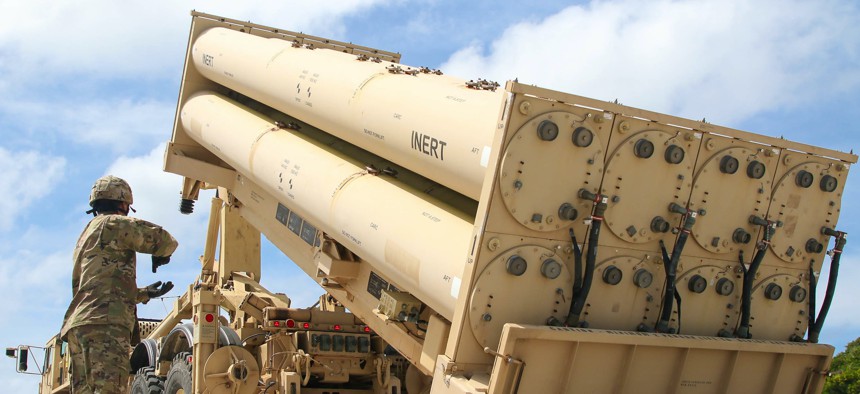Missile Defence Agency Funny Stalin Face

U.S. Army Cpl. Rogelio Argueta, Patriot Launching Station Enhanced Operator-Maintainer, assigned with Task Force Talon, 94th Army Air and Missile Defense Command gives commands, during a practice missile reload and unload drills on a Terminal High Altitude Area Defense (THAAD) system trainer at Andersen Air Force Base, Guam, Feb. 6, 2019. U.S. Army / Capt. Adan Cazarez
The "hardest" challenge the Missile Defense Agency will face in protecting Guam from missile threats will be integrating multiple data streams into a single, coherent picture for commanders, the agency's commander said Monday. To address that challenge, the agency hopes to build an integrated missile defense command and control center on the island, which would give military leaders better control over the variety of missile defense tools at their disposal, Vice Adm. Jon Hill said.
Guam is expected to play a critical role in the U.S. military's future efforts to deter a Chinese attack on Taiwan, and would be among the first targets of Chinese long-range missile strikes in the event of armed conflict. Over the years, the U.S. military and MDA in particular have added missile defense capabilities in the region—land-based defenses on Guam itself, such as the land-based Terminal High Altitude Area Defense system and soon the Patriot missile battery, as well as ship-based interceptors. paired with a variety of radar and other sensors.
But as CSIS senior fellow Tom Karako pointed out in a discussion Monday with Hill, that's a lot of different types of information to integrate and respond to across multiple services. Building a missile defense command center on the island would allow Indo-Pacific Command to respond more quickly.
"If you look at the most important thing on Guam, it is going to be that command center," Hill said. "We are going to build it in advance. And I'm going to have [Indo-PACOM Commander Adm. John Aquilino] and his team in there walking and kicking consoles, making sure we have the chairs in the right place…What I want to do and what my team wants to do for Indo-PACOM is to have what we've all talked about for years, a single integrated air picture."
That picture also must be flexible enough to contain new types of sensor data and new types of missile interceptors, such as future ones for highly-maneuverable hypersonic weapons, he said.
The new class of highly-maneuverable hypersonics are sometimes described as "invincible," but developing new interceptors that can effectively take them out is a big part of MDA's future. The agency requested $130 million for the Hypersonic & Ballistic Tracking Space Sensor and Space-based Kill Assessment in its most recent budget request.
But Hill said the Defense Department is still trying to solve some hard physics and engineering problems before it can determine what hypersonic missile defense will look like.
Much of it depends on the effects of incredibly high temperatures on sensitive, missile-finding technology in the nose of the interceptor missile, a portion of the interceptor sometimes called the seeker. That seeker is going to experience a wide range of conditions as it plows through the atmosphere into space, and then comes back down to "near space" where it can effectively intercept the incoming missile.
"There's concerns about seeker, the seeker window materials. We have concerns about propulsion and divert and the attitude control system because it's a different environment," Hill said. Future hypersonic interceptors will "have to operate in space; that's one environment, operate in the atmosphere; that's a different environment. And that glide environment that's 50 to 70 kilometers up, that is a different environment. And we're going against a different kind of threat that's in a maneuver state."
Understanding how physics will affect seeker electronics across those different altitudes will drive future investment, he said.
Source: https://www.defenseone.com/threats/2022/05/missile-defense-agency-eyes-command-center-guam/367311/
0 Response to "Missile Defence Agency Funny Stalin Face"
Post a Comment